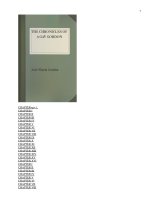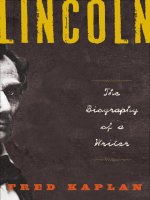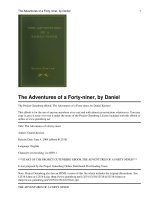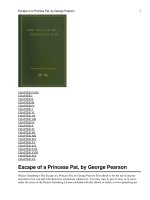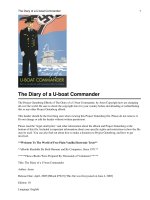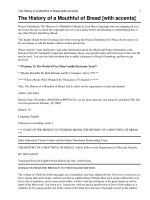THE RISE OF A NATIONAL LITERATURE
Bạn đang xem bản rút gọn của tài liệu. Xem và tải ngay bản đầy đủ của tài liệu tại đây (672.46 KB, 21 trang )
THE RISE OF A NATIONAL
LITERATURE
- In the early years of the new republic, there was
disagreement about how American literature should grow.
- Worried
that
American
literature
lacked
national
feeling .
How America
literature
should grow
- American
literature was too
young to declare its
dependence from
the British literature
tradition.
- American
literature
was a
mistake,
good
literature
should be
universal
=> As American literature grew and flowered, a greatest writer
found a way to combine the best quality of the literature of the
old and New Worlds.
THE RISE OF A NATIONAL LITERATURE
- Novel were the first popular literature of the
newly independent United States:
1. Novel has been considered a dangerous
form of literature by the American
Puritans who thought novels put
immortal ideas into the head of young
people
2. The language of these novels spoke
directly to ordinary Americans
3. helped Americans see themselves as a
single nation
THE RISE OF NOVEL.
Novels had used realistic details to describe the reality of
American Life. It was suppressed as morally dangerous.
-Ex: Power of Sympathy ( 1789) – William Hill Brown.
THE RISE OF NOVEL
Later novelists filled their novels with moralistic advice
and religious sentiments to make them acceptable .
N: Charlotte Temple (1791) - Susanna Rowson.
HUGH HENRY BRACKENRIDGE
(1748-1816)
1. Modern Chivalry (1792-1815)- the first important
novel.
i
- The book is a series of adventures in which the author
makes fun of America’s “backwoods” culture and
customs (slavery and sword fights), religious and national
groups (the Quakers, the Irish, the Indians). The
weaknesses of American democracy are also described.
2. Like Susanna Rowson, he wanted to achieve a reform
in morals and manners of the people.
GILBERT IMLAY (1754-1828)
Emigrants (1793)
1. English families who moved to America to live
in a frontier settlement found happiness in
contrast to those who held the false old values
of English society were ruined
2. showed American culture to be more natural
and simple than the old culture of Europe
CHALES BROCKDEN BROWN ( 1771-1810)
1. He interested in the psychology of
horror and he had the ability to
describe complicated (and often
cruel) minds (p.29)
2. influenced writers as Hawthorne and
Poe
3. Wieland (1798), Ormond (1799),
Arthur Mervyn (1799), Edgar
Humtly (1799)
ROYALL TYLER
-
He wrote one of the best realistic
novels of this period. (The contrast)
Algerine Captive (1797)
1. the protagonist is made a slave by
pirates after his ship that carries black
slaves sinks.
2. an attack on the American government
for its support of slavery (p.30
THE PERIOD OF “KNICKERBOCHKER” (1810 – 1840”
The name “Knickerbockers” (p.30-31)
1. comes from Washington Irving’s A History of New
York by Diedrich Knickerbocker (1809) -- a local
history of New York
2. By the early 1800s -- two hundred years after Henry
Hudson arrived -- most New Yorkers knew little about
their city's history. Few even knew that Manhattan was
once New Amsterdam
3. “Diedrich" means "father" in Dutch, and the last name,
according to the author's note, meant "to nod or doze
over books”
Knickerbocker's New Amsterdam
WASHINGTON IRVING (1783- 1859
The Sketch Book (1819) contains 32 stories two
best loved stories: “Rip Van Winkle” and “The
Legend of Sleepy Hollow” (p.31-32)
Plots are based on old German folk tales
Few of the stories are really original; his writing
materials come from nations of Europe
the first Ameriacn to earn his living through
literature
considered feeling and language as more
important elements in his art than story or
character
regarded the story simply “as a frame on which
I sketch my materials”
Rip Van Winkle
JAMES FENIMORE COOPER (17891851)
wanted to speak for all America (since
Neither Irving nor otheR Knickerbockers
really tried to speak for the whole country.
Their whole world tended to stop at the
borders of New York State.)
his books contain much thoughtful criticism
of American society
In Europe, Cooper was known as “the
American Walter Scott” (who wrote
adventure stories filled with historical
details)
considered his works to be completely
original
their characters are “American,” the pioneer,
the Indian and the Yankee sailor
The Spy (1821), his first successful novel
“Leatherstocking” Series
The Pioneers (1823) – p.34-35
set in the exciting period America’s
movement westward.
the main character Natty Bumppo, a
typical American pioneer figure, a master
of all the skills needed to live in the forest,
deep love for nature, sympathy for all
people, including Indians
race conflict between white and Indians
Uncas and Chingachgook are Natty’s best
Indians friends – noble savages
the Indians, dying race, were sacrificed to
the advance of white culture
“Leatherstocking” Series
The Last of the Monicans (1826)
The Pathfinder (1840)
The Deerslayer (1841)
Sea Stories
civilization over the wilderness
most successful descriptions are on violent action,
night-time terror and mystery
women characters are weak
THE LAST OF THE MOHICANS
The Last of the Mohicans is the 1826 sequel to the now lessfamous The Pioneers (1823) and the prequel to The Prairie
(1827). It is set at the time of the war between France and
England in North America and, as the novel begins, we are
already three years into the conflict. At Fort Edward, General
Webb receives news of a French attack under Montcalm is
coming to Fort William Henry which is only guarded by the
small force of the Scotsman Monro. Captain Duncan
Heyward is dispatched to take Munro’s daughters to that Fort
along with the renegade Native American runner Magua,
known as Le Renard Subtil (The Cunning Fox). The
magnificent Chingachgook whose son is the last of the
Mohican tribe, and find that Magua is actually preventing
their progress and is allied to the French. Hawkeye (Natty
Bumppo, the central character in these ‘Leatherstocking
Tales’) and follow him and his Indian companions as they
become involved in the bloody war. Hawkeye is seemingly
the last decent white man as he respects the Indians’ customs
in this exciting adventure story full of battles, captures and
rescues .
The Last of the Mohicans
Chingachgook
Hawkeye (Nathaniel
Bumppo)
WILLIAM CULLEN BRYANT(1794- 1878)
Disliked the old neoclassical style :
new poetry should not simply copy the forms and
ideas of the ancient classics
should break away the old patterns
understand the world through his emotions
its aim is to find a new higher kind of knowledge
nature poetry, paved the way for the
Transcendentalists (who believes that man can
find truth through his own feeling)
a poet with a deep social conscience, fought hard
for the rights of the laborer and of blacks, “The
Indian Girl’s Lament” and “The African Chief”
WRITERS IN THE SOUTH
o
John Pendleton Kennedy (1795-1870) wrote
Swallow Barn (1832)
o
William Gilmore Simms (1806-1870)
• The Yemassee (1835), his best work
interested in Indian society as a whole, their
customs and psychology are studied in detail
• a work of literature and history
• believed that “it is the artist only who is
the true historian”

